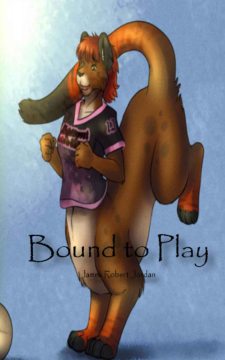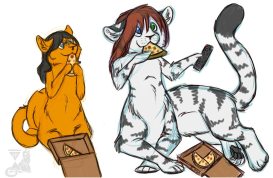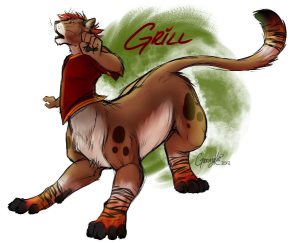Review: 'Bound to Play', by James Robert Jordan
 Bound to Play is set in Bernard Doove’s Chakat Universe. It features those hermaphroditic centauroid felines, along with their national game of Chakker. Chakker is explained in Doove’s “The Great Game of Chakker”, in his Tales from the Chakat Universe or on his website.
Bound to Play is set in Bernard Doove’s Chakat Universe. It features those hermaphroditic centauroid felines, along with their national game of Chakker. Chakker is explained in Doove’s “The Great Game of Chakker”, in his Tales from the Chakat Universe or on his website.
Chakats Grill and Midsun are cubhood friends living in Melbourne on Earth in the 24th century, where there is a large Chakat community. They are also Chakker enthusiasts who are now in their late adolescence and on the same junior league team, the Blind Bight Cubs. Although they are hermaphrodites, Grill is more masculine and Sun is more feminine; something that they have always been aware of intellectually but now feel emotionally since they are going into heat. Being Chakats, they are less embarrassed about mating in public than being caught mating together since they are known to their families as just Best Pals.
CreateSpace, May 2012, trade paperback $12.99 (xv + 142 pages), Kindle $8.00. Illustrated.
Most Chakats are strongly empathetic. “Chakats under the age of eighteen played [Chakker] in the junior league, and the standing rule was they were required to wear headbands that had built in empathetic dampeners so the passion of the moment in an intense game didn’t cause problems.” (p. 5) Grill persuades Sun, who is more skilled at electronics than shi is, to work up a tiny device that blocks the dampening so they can use their empathetic bonding to improve their Chakker teamwork. This is cheating, and of course they get caught at it. Worse – or better – the emotional intensity of practicing together without the dampening creates a permanent bonding that makes the two lifemates whether they like it or not. Fortunately, they do. Even more fortunately, their “mothers” are best friends who, being hermaphrodites, are considering becoming more than that. But they do not hesitate to punish their children for the cheating.
 Grill and Sun are allowed to play in the junior league finals against the Werribee Roos, since it would wreck the Blind Bight Cubs to pull them out at the last minute. But Grill is kidnapped by a human professional criminal who blames his family for having foiled a paid sabotage attempt, ruining the criminal’s credibility. The climax is Grill’s rescue.
Grill and Sun are allowed to play in the junior league finals against the Werribee Roos, since it would wreck the Blind Bight Cubs to pull them out at the last minute. But Grill is kidnapped by a human professional criminal who blames his family for having foiled a paid sabotage attempt, ruining the criminal’s credibility. The climax is Grill’s rescue.
Among all this are numerous other Chakats, including Midsun’s mother Midsnow, Grill’s mother Blacktail, their other siblings (including Coldeyes and Coalspot, who Blacktail is the “father” of), Sun’s and Grill’s fathers, lots of humans, a rabbit morph college professor, a wolf morph policewoman, a rat morph secretary, a foxtaur and his badger morph mate … there is plenty here for the Furry fan. The erotic scenes are mild and in good taste. Give Bound to Play a PG to R rating. There are also illustrations by eight artists, all on Fur Affinity; not counting the cover artist, Mosa Sakkine.
 Now for the real criticism. Either this book has not been proofread or the author does not consider capitalization consistency important. I am guessing that Chakats and Chakker should be capitalized because they are lower-case about half the time. So is the difference between Blind Bight and Bind Bight. The only word for laughter that the author seems to know is “giggle”. Everyone giggles all the time. I have no objection to young children or women giggling, but it seems unmanly for the adult males to giggle. (All right; call me a sexist.) Sentence structure leaves a lot to be desired. The first two sentences of this novel are, “The door slowly creaked as it opened. The white pawed footsteps moving slowly against the laminate flooring hoping to not make any more sound then what was already made.” (p. x) One of the weaknesses of CreateSpace is (I am guessing) that they do not do any editorial criticism of the works submitted to them for publication. (For example, I would recommend, “The door creaked as it slowly opened.”; a “slow creaking” is improbable.)
Now for the real criticism. Either this book has not been proofread or the author does not consider capitalization consistency important. I am guessing that Chakats and Chakker should be capitalized because they are lower-case about half the time. So is the difference between Blind Bight and Bind Bight. The only word for laughter that the author seems to know is “giggle”. Everyone giggles all the time. I have no objection to young children or women giggling, but it seems unmanly for the adult males to giggle. (All right; call me a sexist.) Sentence structure leaves a lot to be desired. The first two sentences of this novel are, “The door slowly creaked as it opened. The white pawed footsteps moving slowly against the laminate flooring hoping to not make any more sound then what was already made.” (p. x) One of the weaknesses of CreateSpace is (I am guessing) that they do not do any editorial criticism of the works submitted to them for publication. (For example, I would recommend, “The door creaked as it slowly opened.”; a “slow creaking” is improbable.)
There is a good story here. But you have to plow through what would get so many red markings if this was a school paper that it would look like the manuscript was splattered with red paint. The book ends with a preview of the sequel, The Cat’s Eye Pub. I seriously suggest that the author have someone with editorial experience fix it up before it is submitted to a publisher.
About the author
Fred Patten — read stories — contact (login required)a retired former librarian from North Hollywood, California, interested in general anthropomorphics
Comments
CreateSpace is just Amazon's print-on-demand printing service, not a publisher in the traditional sense of the word, so no, there's no editorial control on their part.
If a writer is too lazy to use proper grammar, I'm not going to waste my time or money on his, or her, stuff.
While neither defending nor decrying the quality of the grammar in the book, please do not confuse the author's level of grammar skills with laziness.
An author's general lack of grammar skills doesn't imply laziness, but putting a finished product out there for sale with tons of grammar mistakes does. If you expect people to pay money for your book, you have to respect their time and money enough to offer a polished product. I don't even waste my time reading free books with lots of typos or errors.
I'd suggest you're both right, in a sense. It's not "lazy" to have errors -- whether grammatical or typographical -- but that doesn't mean it isn't problematic. I recently reviewed a small press anthology (the review will be up here soon, I think) and I think it's genuinely worth buying, and said so. But it's very clear whoever did the book layout simply doesn't know the basics of how book layout works, to the point where even people who aren't typography nerds like me would flip through it and think it looked pretty amateurish. They might not be able to explicitly say why it gave them that impression, but they'd very likely still have it.
For fiction work there's strong value in having works vetted by an editorial process. Partially this is to get the "polish" you refer to, but partially it's also to do some level of curation. If you buy a book from Tor or Baen -- or from Sofawolf or FurPlanet -- the book you're purchasing is one that someone with a level of professional editorial experience read, liked, and very possibly improved. That doesn't guarantee you'll like the book, nor does it guarantee that everything that's rejected by Tor or Baen (or Sofawolf or FurPlanet) is stuff you wouldn't like, but as someone who's had the experience of reading the slush pile at several paying fiction markets with open submissions, I can verify that a significant majority of what gets rejected isn't being rejected as a matter of editorial taste or commercial marketability concerns, it's being rejected because it's Just Not Good. While I agree with Goldfur's general take on CreateSpace, they can very easily be used as a vanity press. That alone isn't a guarantee of badness -- I have friends who've self-published some very high-quality work -- but it puts all the editorial, proofing and layout work in the hands of authors who may not be very good at those tasks even if they are good writers, and puts the curation work in the hands of readers who, if they get a couple turkeys, may very well become wary of all self-published material.
— Chipotle
Okay, let me rephrase what I said: If the writer is too lazy to proofread his, or her, own stuff, I'm not going to waste my time and/or money on their story.
The strength of publishers such as CreateSpace is that authors who might never be otherwise seen, can get their works out to people who are interested in what they have to offer. The great weakness is that there is no editorial control whatsoever. Anyone who seriously wants to make a career out of writing should definitely get their works proofread and edited first. However, for books like these, I'm more inclined to judge on the strength of the story first.
For the record, both "chakat" and "chakker" should not be capitalized any more than you would capitalize "fox" or "football".
Why should "books like these" be any different? Readers are still paying actual money for them and still spending actual time reading them.
With how religious some people are about football I'm surprised it isn't capitalized.
To anyone interested enough to read the story but reluctant to pay for it, it may be found online here (disclaimer: I cannot vouch for how closely the online version matches the published version). I might read it (so many stories, so little time). Up to a point, I can be pretty forgiving about grammar and style problems if I'm drawn in by the characters enough to care about what happens to them, so it may well be worth my time. But my money? It sounds as if this story lacks the degree of polish I would expect from something I'm paying for.
Edit: I read the online version and while I agree with the criticisms that have been brought up here I found it an enjoyable read nonetheless. After finishing it in only about an hour, I cut-and-pasted it into my word processor to check the word count - at a little under 25K words it would only be considered a novella.
Hopefully the published version is longer, since $8 would be a pretty steep price for a novella-length e-book even if the writing were well-crafted.
At 158 pages, I'd be (mildly) surprised if the printed version hadn't been expanded a little; my upcoming "Indigo Rain" is over 27,000 words and will be fewer pages, unless it's typeset with REALLY BIG TEXT. (The typesetting of "Bound to Play" looks like pretty big text, mind you, judging by Amazon's display.)
I don't know what the overhead of this particular book was, but getting cover illustrations and a few interior illustrations from a capable artist is going to be several hundred dollars (ask me how I know), and the base printing cost from CreateSpace or similar for a novella-sized book at a standard trade paperback trim size is going to be ~$2.50 a copy. I suspect FurPlanet's price of $10 for the Cupcakes line is pretty well chosen for having any chance of making a profit. That's more expensive than a book from a conventional publisher would be, but we can't make it up in volume, as they say.
For a novella-length ebook I agree that $8 seems steep, although I keep suspecting I've underpriced my own ebook at $3.99. This is still somewhat uncharted territory for a lot of us.
— Chipotle
The entire Prologue in the book is not in the online version, so the book has been expanded by at least that much. I have not compared the two versions in detail to see if the book has any other new additions.
Fred Patten
The Prolouge and a chapter detailing Midsun and Grill's first intimate encounter as well as "The Cat's Eye Pub" preview is what has been added to the book and e-book versions. E-books being such a new format I wasn't sure honestly what price to put the kindle version at and just went on a hunch. Going forward it seems I will need to be more mindful of cost to consumers. But to be honest I'm not in it for money but merely made the printed version for those who wanted paper back copies. And the Kindle version for those wanting the illustrations in color.
As a side note the illustrations while costly in terms of the artist (all of which are wonderful and I highly recommend to be commissioned should you desire any art) is not something I am trying to recopperate as I commissioned these fine people for my own enjoyment. Art can add up quickly as another commenter mentioned.
I find this review to be very fair and going forward I will make sure to have editors look over my work from now on. I do find a particular comment in this comment section from a Anon to be of interest. Please understand there is no "Laziness" on my part. I am nor will ever claim to be an english major or even concede that english in the written language is something I am truly adept in.
Again that being said I hope to further my grammar and continue to make stories that entertain with the help of those who are adept in English. Fred thank you kindly for your review.
Post new comment